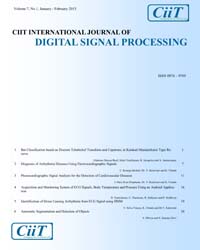An Efficient Classification of EEG Signals for Epilepsy Based on Discrete Wavelet Transform and Approximate Entropy Using Constrained Neyman-Pearson Criteria
Subscribe/Renew Journal
EEG (Electroencephalogram) signal is summation of electrical activities that stores information about states of human brain. In order to improve the performance of EEG, de-noising is required which is done by using Discrete Wavelet Transform (DWT). In this paper, a new technique is presented for detecting epileptic seizures from 16-channel EEG data recorded from two groups of patients:normal and epileptic. This technique is based on approximate entropy (ApEn) and DWT analysis of EEG signals. Seizure detection is accomplished in two stages. In the first stage, EEG signals on each channel are decomposed into four levels using multi-resolution wavelet analysis to get approximate and detail coefficients. In the second stage, ApEn values of the approximation and detail coefficients are computed. For separating two groups, student t-test statistical analysis is used which estimates confidence interval (CI) and segregation probability (p-value). Past work in the EEG classification area has been done using ApEn with single threshold Neyman-Pearson criteria, but through experimental analysis here we have used Upper and Lower threshold values for the efficient EEG classification based on Constrained Neyman-Pearson criteria. Signals with ApEn less than the threshold are classified as epileptic EEG and signals with ApEn greater than or equal to the threshold are classified as normal EEG. Experiments show that best detection rate is obtained at D2 sub-band, and it assures a higher detection rate with a lower false detection rate.
Keywords
Electroencephalogram (EEG), Discrete Wavelet Transform (DWT), Approximate Entropy (ApEn), Student T-Test, Noise Rejection, Neyman-Pearson Criteria.
User
Subscription
Login to verify subscription
Font Size
Information

Abstract Views: 327

PDF Views: 2



